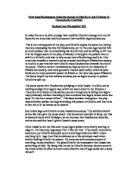Daniel Walker
14th of October 2006
Examine the Method that Shakespeare Employs to Make the Final Scene of “Othello” Dramatically Effective
Scene 2 of Act five in William Shakespeare’s “Othello” is the climax of the play. The reason being, in this scene the tragic hero, Othello, kills his wife, Desdemona, as he believes that she has slept with one of his men, Cassio. However, this is merely a plot formed by, Iago, one of Cassio’s former peers, whom he is jealous of as the promotion he hoped to get was given to Cassio by Othello.
Much of the dramatic tension comes from the agonising wait that Shakespeare makes his audience endure while Othello performs his soliloquy and they don’t know whether Othello will not only kill his wife, Desdemona. This is a very strong contrast to the chaotic events that take place before this scene and provide a dramatic atmosphere not yet explored in the play. Throughout the play audiences sympathy for Othello has been preserved, as he has been the innocent party. This innocence is now at stake as he contemplates with increasing intent, the possibility of killing her. It seems that for once in the play, time slows down to a crawl as Othello’s mind races back and forth over this moral dilemma. What only increases this tension is greatened by Othello’s persistent wavering indecisiveness that can be illustrated by the first line of his soliloquy, “It is the cause, it is the cause, my soul”. This repetition of the phrase “It is the cause” is saying that he cannot find a just enough reason to kill her and that he is finding it impossible to leave his beloved wife. On the other hand Othello feels that it is his duty as an enforcer of justice to prevent Desdemona from doing the same to other men (saving mankind) and committing further sins.

This is a preview of the whole essay
Peer Reviews
Here's what a star student thought of this essay
Quality of writing
The essay has a clear introduction, but lacks a conclusion which is a shame. A weaker point of this essay are the signposts for each paragraph - they tend to be lengthy and so lose focus slightly. Having concise and clear starting sentences allows the point to relate directly back to the question. The language used in this essay is sometimes colloquial such as "the tension really starts to build up" - making it more sophisticated would be wise. Otherwise, spelling, punctuation and grammar are strong.
Level of analysis
The analysis in this essay is sound, exploring language and imagery techniques used by Shakespeare. I liked how quotes were well embedded as this ensured the analysis flowed nicely, also allowing a close focus on the techniques and the dramatic effect. Technical terms are used well, such as tension and the focus on Othello's soliloquy. I would've liked to seen some recognition that this is, in fact, Othello's first soliloquy of the play, showing Iago's influence over him. There is no discussion of the hatred for Iago throughout, which is a key part of the dramatic ending, where he says nothing after Othello has killed himself. It would have been stronger if the essay had explored the bloodiness of the final scene, as this would've been a potent image on stage.
Response to question
This essay engages with the task set well, but there are plenty of parts which could be improved. I would've liked to have seen the introduction expand on the connotations of a tragedy's climax, as this would've led to a focus throughout the essay on catharsis and other tragic techniques. There are times when the audience response is explored, however this is not enough! I like how the second paragraph begins by showing awareness of Shakespeare's construct, yet this is the only occurrence.








